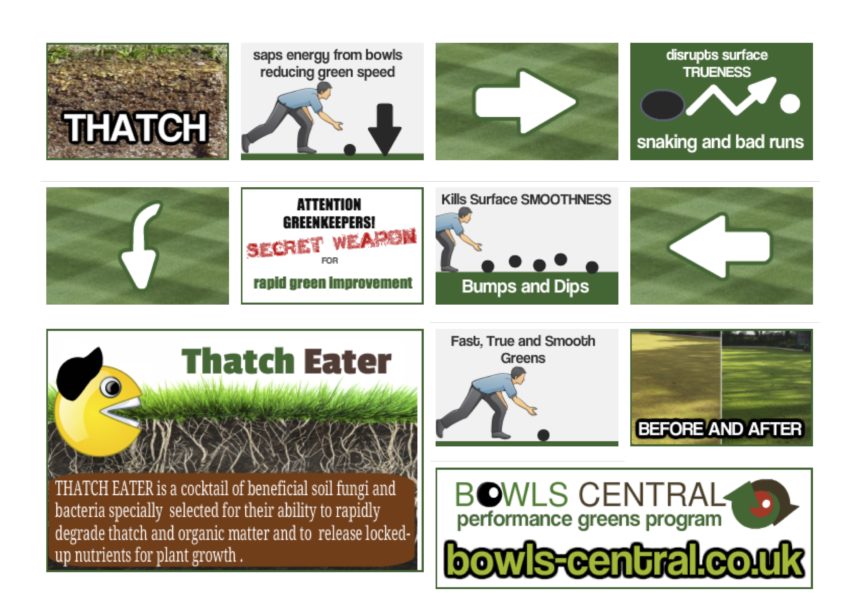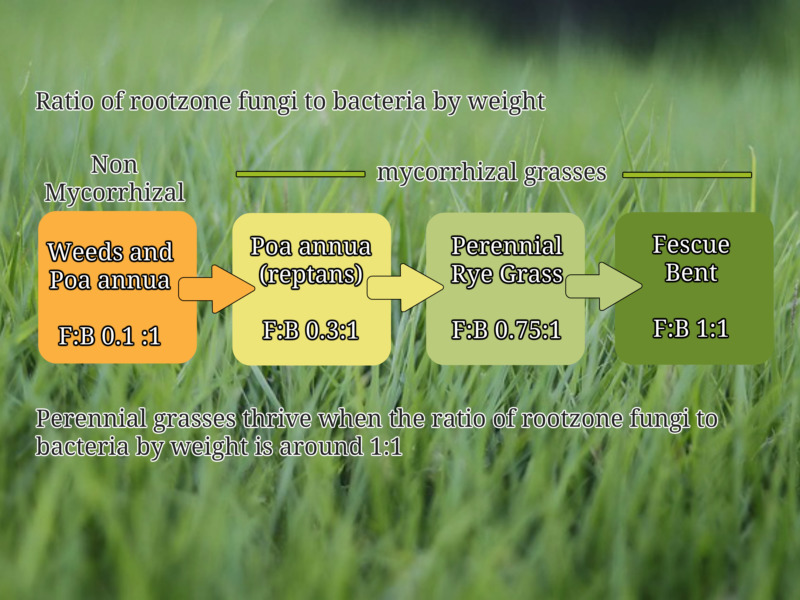Do nothing greenkeeping sounds tempting doesn’t it?
The decades of reactive greenkeeping when we relied on pesticides and synthetic fertilisers are well and truly in the past. Even if you wanted to follow that path, most of the pesticides are now banned.
Add into the equation some hard facts:
- Fungicides kill off beneficial Soil Fungi. The fine perennial bent and fescue grasses rely on a balanced soil microbiome to thrive, so when we kill off beneficial soil fungi, we actually encourage Poa annua invasion
- The build up of mineral salts in the soil from synthetic fertilisers actually reduces the plants’ ability to take in water and nutrients from the soil via osmosis.
- A healthy soil microbiome with a balanced and thriving population of Fungi, Bacteria and other soil microbes can produce 50% of the Nitrogen requirement of an average green simply by breaking down the material that usually builds up into thatch. Thatch only occurs in greens that are too intensively managed and particularly those that are bombarded with high salt minerals and pesticides.
****************
In one of my favourite books, Masanobu Fukuoka describes how he had a moment of enlightenment that convinced him to turn his back on a prosperous career in crop science to return to his small family farm in the hills of Japan.
Once there, he developed methods of agriculture based on watching nature and working with it. He is famed for achieving yields of rice and other crops in excess of the conventional agricultural movement with no pesticides or synthetic fertilisers and also for the name he gave his method…Do Nothing Farming! His book is called the One Straw Revolution if you are interested in reading about his life.
****************
Bowling Green Deterioration
The condition of many bowling greens has deteriorated as a result of conventional, reactive greenkeeping and if that isn’t enough to convince clubs to return to a more natural greenkeeping program, then the potential to reduce the most expensive physical work and treatments should be.
The build up of thatch isn’t a natural phenomenon; you won’t see thatch on natural grasslands or even on less intensively managed amenity turf. Thatch builds up simply because there isn’t enough life in the soil to recycle it into humus, where it becomes a key player in the Nitrogen Cycle.
Thatch Destroys Bowling Green Performance

I created the graphic above to promote Thatch Eater, but it illustrates well how the unnatural build up of thatch destroys the performance of bowling greens. This is only the beginning of the detrimental effect of Fungicides and High Salt Minerals. The lack of life in the soil also contributes to further disease, localised dry patch and drainage problems, not to mention the encouragement of Annual Meadow Grass (Poa annua).
How to turn things around
Healthy grass plants growing in healthy soil do not suffer from plant diseases.
The soil microbiome (billions of microbes such as fungi, bacteria and protozoa) obtains its food from the plants already living on the surface, so it has evolved symbioses that naturally protect the plants it relies on for sustenance and survival:
- Competitive exclusion: When one species has even the slightest advantage over another, the one with the advantage will dominate in the long term and this is what a healthy soil microbiome assures for the fine perennial grasses, to the detriment of annuals like Poa annua.
- The microorganisms that stand to most benefit from a long term relationship with our grass plants form a protective barrier around the root system of those plants.
- In a healthy soil with a thriving microbiome, beneficial microbes actually predate on pathogenic ones.
- Microbes produce antibiotics to wipe out plant pathogenic or harmful microbes such as fungal diseases in the soil.
The Importance of Bio-Stimulants
Just like Masanobu Fukuoka’s Do Nothing Farming, the Performance Bowling Greens Program is actually aimed at returning fine turf greens to a much more natural state, making sure that they are sustainable, not only in terms of effort and costs, but also in terms of performance. Healthy, lively greens perform better, because they naturally encourage the finer grasses and don’t allow thatch to build up at the surface.
To achieve this turn around we turn to Bio-Stimulants. Sounds complicated, but all I mean by that is to apply materials to the green to aid the development of a lively and balanced soil microbiome. Simple carbohydrate rich bio-stimulants like Seaweed and Molasses stimulate the growth and reproduction of soil microbes like fungi and bacteria and they make the soil work for its living.
Aeration
The most important Bio-Stimulant is Oxygen, so aeration forms a big part of the Performance Greens Program. Thatchy, inert, overly sandy greens very frequently show signs of being anaerobic, so simply allowing Oxygen in via Sarrell Rolling or Mini Tining will immediately bring results.
Aeration will continue to be an important part of the program even in later years, but the intensity and disruption caused by the most disruptive aeration practices can be left behind eventually.
In the early days of your turnaround program it will be beneficial to use a means of boosting the effect of Oxygen in the soil using Liquid Aeration.
Compost Tea
By brewing and applying your own Compost Tea, you continually add a full compliment of the most beneficial soil microbes including the all import thatch degrading fungi. When these microbes get to work on thatch in the presence of sufficient food (carbohydrates/bio-stimulants) and oxygen they convert previously troublesome dead plant material into Stable Organic Matter (Humus). Humus is the natural support system for the beneficial microbes that contribute to a healthy soil microbiome.
If your green frequently suffers from disease outbreaks, applying compost tea, along with simple bio-stimulants will encourage your soil to quickly develop a strong and healthy population of beneficial microbes and a vast reduction in fungicide use. In fact it’s not uncommon for fungicides to become unnecessary.
Thatch Eating Fungi
A very quick start can be made on degrading excessive thatch by using Thatch Eater, a cocktail of beneficial soil fungi and bacteria specially selected for their ability to rapidly degrade thatch and organic matter and to release locked-up nutrients for plant growth, converting it to humus. The bacteria and fungi in Thatch Eater are centrifuge-dried into a zeolite carrier to enhance their metabolism and to protect them from ultra violet light and chemicals.
This process will release a lot of nutrient from the recycled thatch. If the grass looks hungry, especially after heavy rain, first aerate with micro tines or a sorrel roller, to reactivate the microbes and release enough nutrient to strengthen and colour the sward.
You can then Apply fertilisers only when necessary, safe in the knowledge that nutrient is being released from the decomposition of organic material.
Encourage only Perennial Grasses and Slash Costs
Every year many clubs go through the arduous and expensive process of an intensive autumn program, including Hollow Coring, Sand Top-Dressing and Overseeding. A conservative estimate of the cost of such a program is somewhere around £1800 + VAT.

Much of this work and expense is wasted, unnecessary and sometimes even detrimental to green condition and performance. For example, for every 100 bowling green soil analyses I do, 98 are already too sandy. This means that adding more sand as topdressing is actually contributing to the decline of these greens. Into the bargain, when these greens are hollow cored, most of what comes out is previously applied top-dressing! The estimated saving by leaving out top-dressing is around £1000 per year!
Hollow Coring is actually very useful for greens where the thatch layer is excessive, but there is no need to top-dress afterwards if your green is already too sandy. Hollow coring followed by a robust scarification in the autumn recycles the old top-dressing back into the green surface, allowing you to save the money on buying new material and having it spread onto the green. Even on densely thatched greens, hollow coring can be dropped out of the program usually after 2 or 3 years. No hollow coring means a saving each year of about £400.
Overseeding with fine bent and fescue grass seed every year is futile whilst your green has a thick blanket of thatch, inert sandy soil lacking in humus and when you are actively using high salt mineral fertilisers and fungicides. Greens like this will always revert to Poa annua, regardless of how much seed is added. In fact I estimate long term success with overseeding at somewhere around 2% survival. Leaving unnecessary over-seeding out of the program will save you around £400 for seed and application. Once you are on top of the thatch and soil health issues, then over-seeding can be a very effective add on to boost the composition of the sward.
By encouraging the microlife in your soil with simple Carbohydrates (Bio-Stimulants) and Oxygen, Brewing your own compost tea and dropping out much of the intensive and previously considered essential maintenance you can have a much better green for a lot less effort and cost.
You will be setting your green up to naturally favour the fine perennial grasses like bentgrass and fescues. There will be no need to follow dangerous Poa stressing regimes and/or to put your position as greenkeeper at risk doing so.
The answer lies in the Biology
The key to growing fine perennial grass is in the soil biology. Poa annua thrives in bacteria dominated rootzones, but the fine bents and fescues form symbiotic relationships with mycorrhizal fungi and live best in a balanced fungal/bacterial rootzone.
Although the Performance Greens Program Approach isn’t exactly Do Nothing, it represents a sensible approach to reducing the disturbance to the turf, allowing it to gradually come back to full health, whilst reducing work and costs significantly. It also makes sure that the work you do is the most beneficial work with limited wasted time, effort and money.
The program aims to get your green (turf and soil eco-system) working as nature intended with no need for pesticides or synthetic fertilisers. The natural breakdown of organic material by beneficial soil microbes will:
- provide free nutrients for your turf, reducing fertiliser bills.
- result in faster, truer and smoother greens
- give you better green performance and reliable consistency
- produce a friable, free draining rootzone
- provide the optimal water and nutrition to your turf
- encourage fescue and bent grasses while discouraging Poa annua
- allow you to significantly reduce maintenance costs while improving playing conditions for your members
How to Get Started
As always the best starting point is to make a thorough evaluation of your green and soil. A Chemical and Peak Sand Analysis will tell you how your green is in terms of soil chemistry and texture. As part of the service I will gather further information about your green by email. From there I will assess your green’s condition and write a report including a step by step plan for improving your green and saving money on maintenance.
Order your Soil Analysis today to get started on a journey you’ll never regret taking.
Re-Charge your Humus…a simple plan to start the recovery this Autumn
 If you are having trouble with your green that results in some or all of the following:
If you are having trouble with your green that results in some or all of the following:
- dry patches
- excessive thatch build up
- spongy, soft turf that you can leave footprints in
- Poa annua domination of your sward with ugly seed-heads in June
- frequent disease outbreaks
- slimy, slippery turf
- tricky runs, bumps and dips on your surface
- moss infestation
- sickly, smelly soil when you take a sample
You almost certainly are dealing with a green that has gone beyond Peak Sand. Adding sand top-dressing to this situation is just going to make things worse agronomically and financially for your club.
Greens that have gone beyond Peak Sand i.e. that have had too much sand applied over the years are essentially inert, with no soil life to speak of and are usually lacking the life supporting Humus that brings soil to life and keeps it healthy.
So, this year, do your green a favour and instead of applying more sand, follow this simple plan to start re-building Humus in your soil:
-
Aerate your green by pencil tining or mini hollow tining. If you have a lot of thatch (spongy surface), scarify the green first and remove the debris
-
If you are overseeding, then this is the time to do it
-
Then apply 10 bags of Humigranule with a fertiliser spreader and work it into the holes you’ve made with a drag brush or mat.
Put the kettle on and watch your green’s health start to be restored!
The total cost of this process will be less than half that of the usual sand top-dressing operation and will be many times more effective at improving your green’s health and performance.
Of course this isn’t the end of the story, just the start, but by changing your Greenkeeping approach to work with, rather than against nature, you will be doing yourself, your members, your green and your club’s bank balance a BIG favour…enjoy!




